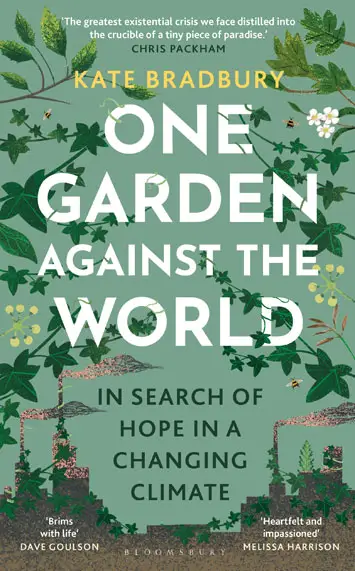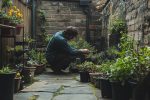One Garden Against the World by Kate Bradbury – Review

By Barney Bardsley
When wildlife writer Kate Bradbury started to write this book, in April 2022, she was filled with worry for the endless dry days we were experiencing, as hardly a drop of rain fell. (This was followed by the heatwave of July 2022, when temperatures reached a record 40 degrees centigrade, even in our cooler UK northern cities.) It felt strange to be reading her words now, in 2024, when – at least for the first half of the year – it never stopped raining at all. But of course, this is all part of the same problem: our ecological and climate change catastrophe.
Kate Bradbury tends a small garden in a terraced house, just outside Brighton. In an increasingly urban environment, she endeavours, with heroic and ferocious zeal, to not only create a haven for our rapidly disappearing wildlife – the insects, bees and butterflies, hedgehogs, frogs and wild birds – but to persuade the rest of us to do the same.
This is her mission statement: “I hope, across the country and indeed the whole globe, we can fall back in love with our environment, and treat it better, through the simple act of tending the spaces outside our back doors. I hope, I hope, I hope.”
From childhood, it was clear that the author was destined to work with the soil. Although she grew up in the suburbs of Solihull, Birmingham – with little access to true wilderness – she nonetheless had an early fascination with nature. “Gardening”, she writes, “was my way to wilder things.”
It was, in particular, the small creatures of the earth, the ants, worms, frogs and hedgehogs, which took her attention. And now, as an adult, it this same delicate eco system, so much under threat from our changing environment, that she battles to support, both in her own garden – by creating happy habitats for bugs and hedgehogs and small nesting birds – and in her campaigning writing.
The statistics she quotes in the book are horrifying. Hedgehogs, in particular, have seen a 95 per cent decline in their numbers since the 1950s. And swifts, those magical seasonal visitors, who depend on insects for their food on the wing, and who return to the same nests year on year – nests that are being built over or destroyed in our quest for modernity – have seen a 60 per cent reduction in the past twenty years.
“Moments of pleasure and wonder”
 So what can we do? We can garden. We can make little ponds. We can let our small green spaces be a little more wild and scruffy, to make habitats for these precious endangered creatures. We can plant trees. We can stop paving over front gardens to make room for yet more cars, thus making flooding and overspill ever more likely. As Bradbury says, “The ground is a sponge. Tree roots are a sponge, and ponds are a sponge. When rain falls, it lands on leaves and trickles slowly into the soil, where it gently seeps into the earth… Our gardens are sponges. Let’s use them.”
So what can we do? We can garden. We can make little ponds. We can let our small green spaces be a little more wild and scruffy, to make habitats for these precious endangered creatures. We can plant trees. We can stop paving over front gardens to make room for yet more cars, thus making flooding and overspill ever more likely. As Bradbury says, “The ground is a sponge. Tree roots are a sponge, and ponds are a sponge. When rain falls, it lands on leaves and trickles slowly into the soil, where it gently seeps into the earth… Our gardens are sponges. Let’s use them.”
It is easy to switch off to ecological warnings such as those given in this book. But we do so at risk of feeling helpless and numb, when in fact, there are plenty of small changes that we all can make. I have recently moved to a terraced house in south Leeds, where many of the streets close by have just yards for gardens. Some people have left the concrete bare. My predecessors, thankfully, made raised beds, and now I have planted trees in pots and made a tiny pond in a metal bowl. I need to see things wild, and let them grow tall, and slowly the bees and butterflies are coming to visit. It is such a relief when they do. As my neighbour said recently, “Have you noticed how few flies there are these days?” In fact, I have counted just two in our kitchen this summer. Small details. Huge consequences.
Whilst it probably isn’t too easy being Kate Bradbury’s neighbour, as she has a beady eye for what you are doing – or failing to do – to encourage the local wildlife to flourish, I am grateful she is there, raising her voice, and and flying the flag, for the creatures and plants that have no voice of their own, and are in danger of being silenced for good.
In the end, it all comes down to love. Being in the garden, however small and modest the space, has always saved me, when times have been tough, and has given me endless satisfaction and pleasure. Indeed, the most moving sequences in this book, are when the author relinquishes her overwhelming anxiety for the natural world, and just remembers the moments of pleasure and wonder that it can give.
When her mother suffered a brain haemorrhage and could not speak or respond, Bradbury moved into her house and tended the garden for her. She took pictures into the hospital, of the little fruit trees that had come into blossom that year, and her mother just “stared at them… with love in her enormous blue eyes.”
Bradbury’s parting shot is a powerful one: “I will never give up on this space, on this world, on the little things I can do every day to keep all this ticking over…I promise to never stop loving it.” Nature heals us. Now we must do our part and help nature to be healed, too.
‘One Garden Against the World’ by Kate Bradbury is published by Bloomsbury









